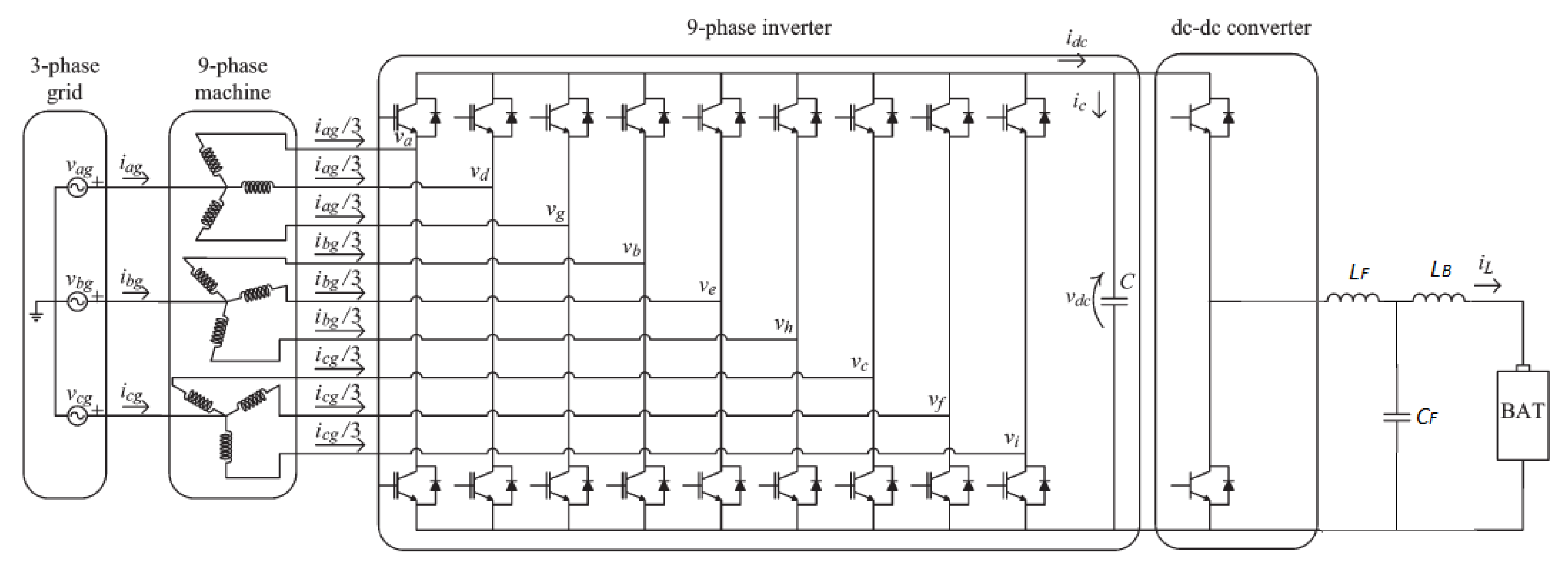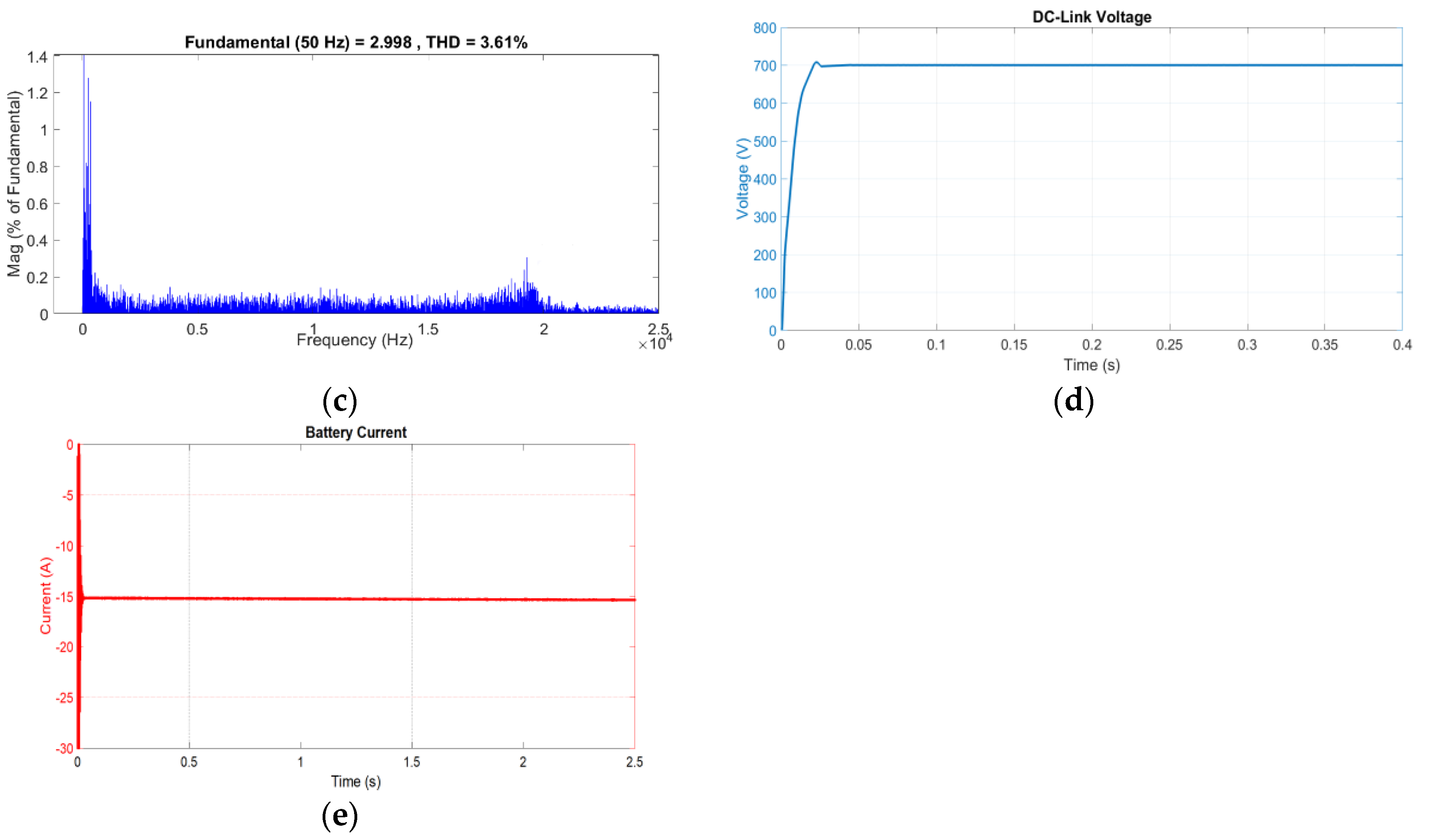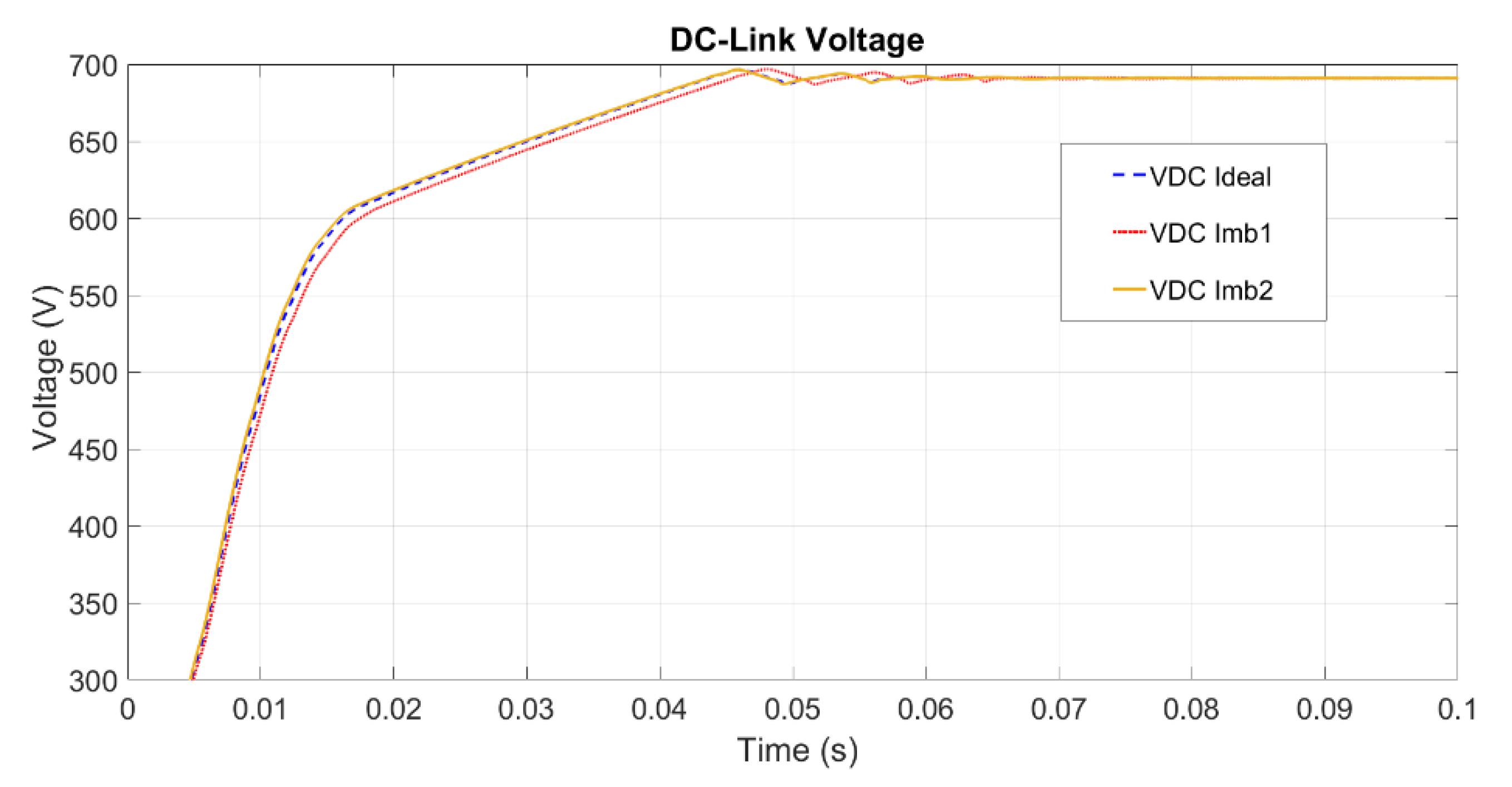A Fuzzy Logic-Based Control Algorithm for the Recharge/V2G of a Nine-Phase Integrated On-Board Battery Charger
Abstract
1. Introduction
2. System Description
3. Proposed Control System
3.1. Nine-Phase PWM Rectifier Control Strategy
3.2. DC-DC Converter Control Strategy
- in CV recharging mode, there is an outer control loop that controls the battery voltage to the reference value. It delivers a reference for the battery charging current flowing in the inductance ILF. The difference between ILF and the measured battery current is given in input to the inner current control loop that outputs the duty cycle for the DC-DC converter. This duty cycle (feedback term) is only a part of the total duty cycle: in fact, it is added to a feed-forward term which is able to considerably improve the start-up behavior of the converter.
- in CC charging mode, the control scheme consists of only the inner current loop that controls the current ILF to the reference value.
- in V2G mode, the control scheme consists of only the inner current loop that discharges the battery following the reference value.
4. Discussion of Considered Case Study
4.1. Simulation Parameters
4.2. Simulation Results
4.2.1. Charging Mode
4.2.2. Discharging V2G Mode
4.2.3. Transition between Different Charging/Discharging Levels
4.2.4. Imbalances Mitigation Effects of the AHBC
5. Conclusions
Author Contributions
Conflicts of Interest
References
- Arias, N.B.; Hashemi, S.; Andersen, P.B.; Traholt, C.; Romero, R. Distribution System Services Provided by Electric Vehicles: Recent Status, Challenges, and Future Prospects. IEEE Trans. Intell. Transp. Syst. 2019, 20, 4277–4296. [Google Scholar] [CrossRef]
- Yilmaz, M.; Krein, P.T. Review of Benefits and Challenges of Vehicle-to-Grid Technology. In Proceedings of the 2012 IEEE Energy Conversion Congress and Exposition, Raleigh, NC, USA, 15–20 September 2012; pp. 3082–3089. [Google Scholar]
- Ehsani, M.; Falahi, M.; Lotfifard, S. Vehicle to Grid Services: Potential and Applications. Energies 2012, 5, 4076–4090. [Google Scholar] [CrossRef]
- Kati, V.A.; Stanisavljevi, A.M.; Dumni, B.P.; Popadi, B.P. Impact of V2G operation of electric vehicle chargers on distribution grid during voltage dips. In Proceedings of the 2019-18th International Conference on Smart Technologies, Novi Sad, Serbia, 1–4 July 2019; pp. 1–6. [Google Scholar]
- Aziz, M.; Oda, T.; Mitani, T.; Watanabe, Y.; Kashiwagi, T. Utilization of Electric Vehicles and Their Used Batteries for Peak-Load Shifting. Energies 2015, 8, 3720–3738. [Google Scholar] [CrossRef]
- Calderaro, V.; Galdi, V.; Graber, G.; Graditi, G.; Lamberti, F. Impact Assessment of Energy Storage and Electric Vehicles on Smart Grids. In Proceedings of the IEEE Electric Power Quality and Supply Reliability Conference, Rakvere, Estonia, 11–13 June 2014; pp. 15–18. [Google Scholar]
- Muñoz, E.R.; Razeghi, G.; Zhang, L.; Jabbari, F. Electric Vehicle Charging Algorithms for Coordination of the Grid and Distribution Transformer Levels. Energy 2016, 113, 930–942. [Google Scholar] [CrossRef]
- Graber, G.; Lamberti, F.; Calderaro, V.; Galdi, V.; Piccolo, A. Stochastic Characterization of V2G Parking Areas for the Provision of Ancillary Services. In Proceedings of the 2017 IEEE PES Innovative Smart Grid Technologies Conference Europe, Torino, Italy, 26–29 September 2017. [Google Scholar]
- Salvatti, G.A.; Carati, E.G.; da Costa, J.P.; Cardoso, R.; Stein, C.M.O. Integration of electric vehicles in smart grids for optimization and support to distributed generation. In Proceedings of the 2018 13th IEEE International Conference on Industry Applications, São Paulo, Brazil, 11–14 November 2018; pp. 963–970. [Google Scholar]
- Amamra, S.; Marco, J. Vehicle-to-Grid Aggregator to Support Power Grid and Reduce Electric Vehicle Charging Cost. IEEE Access 2019, 7, 178528–178538. [Google Scholar] [CrossRef]
- Yilmaz, M.; Krein, P.T. Review of Battery Charger Topologies, Charging Power Levels, and Infrastructure for Plug-In Electric and Hybrid Vehicles. IEEE Trans. Power Electron. 2013, 28, 2151–2169. [Google Scholar] [CrossRef]
- Haghbin, S.; Lundmark, S.; Alaküla, M.; Carlson, O. Grid-Connected Integrated Battery Chargers in Vehicle Applications: Review and New Solution. IEEE Trans. Ind. Electron. 2013, 60, 459–473. [Google Scholar] [CrossRef]
- Singh, A.K.; Pathak, M.K. A Comprehensive Review of Integrated Charger for on-Board Battery Charging Applications of Electric Vehicles. In Proceedings of the 2018 IEEE 8th Power India International Conference, Kurukshetra, India, 10–12 December 2018. [Google Scholar]
- Kamble, A.S.; Swami, P.S. On-Board Integreted Charger for Electric Vehicle Based on Split Three Phase Insuction Motor. In Proceedings of the 2018 International Conference on Emerging Trends and Innovations In Engineering And Technological Research, Ernakulam, Cochin, India, 11–13 July 2018; pp. 1–5. [Google Scholar]
- Jiang, J.; Xia, T.; Ha, Q. A Novel On-Board EV Charger based on Open-Winding PMSM. In Proceedings of the 2017 Chinese Automation Congress, Jinan, China, 20–22 October 2017; pp. 6663–6667. [Google Scholar]
- Turker, H. Review of Electric Motors for Grid Connected Integrated Battery Chargers in Electric Vehicle Applications. In Proceedings of the 2016 IEEE International Conference on Renewable Energy Research and Applications, Birmingham, UK, 20–23 November 2016; pp. 1029–1033. [Google Scholar]
- Barrero, F.; Duran, M. Recent Advances in the Design, Modelling, and Control of Multiphase Machines-Part I. IEEE Trans. Ind. Electron. 2016, 63, 449–458. [Google Scholar] [CrossRef]
- Duran, M.; Barrero, F. Recent Advances in the Design, Modelling, and Control of Multiphase Machines-Part II. IEEE Trans. Ind. Electron. 2016, 63, 459–468. [Google Scholar] [CrossRef]
- Bojoi, R.; Cavagnino, A.; Tenconi, A.; Tessarolo, A.; Vaschetto, S. Multiphase Electrical Machines and Drives in the Transportation Electrification. In Proceedings of the 2015 IEEE 1st International Forum on Research and Technologies for Society and Industry Leveraging a Better Tomorrow, Turin, Italy, 16–18 September 2015. [Google Scholar]
- Malinowski, M.; Kazmierkowski, M.P.; Trzynadlowski, A.M. A Comparative Study of Control Techniques for PWM Rectifiers in AC Adjustable Speed Drives. In Proceedings of the IECON’01, 27th Annual Conference of the IEEE Industrial Electronics Society, Denver, CO, USA, 29 November–2 December 2001; pp. 1114–1118. [Google Scholar]
- Subotic, I.; Bodo, N.; Levi, E.; Dumnic, B.; Milicevic, D.; Katic, V. Overview of Fast On-Board Integrated Battery Chargers for Electric Vehicles Based on Multiphase Machines and Power Electronics. IET Electr. Power Appl. 2016, 10, 217–229. [Google Scholar] [CrossRef]
- Diab, M.S.; Elserougi, A.A.; Abdel-Khalik, A.S.; Massoud, A.M.; Ahmed, S. A Nine-Switch-Converter-Based Integrated Motor Drive and Battery Charger System for EVs Using Symmetrical Six-Phase Machines. IEEE Trans. Ind. Electron. 2016, 63, 5326–5335. [Google Scholar] [CrossRef]
- Bodo, N.; Levi, E.; Subotic, I.; Espina, J.; Empringham, L.; Johnson, C.M. Efficiency Evaluation of Fully Integrated On-Board EV Battery Chargers with Nine-Phase Machines. IEEE Trans. Energy Conv. 2017, 32, 257–266. [Google Scholar] [CrossRef]
- Yu, F.; Zhang, W.; Shen, Y.; Mao, J. A Nine-Phase Permanent Magnet Electric-Drive-Reconstructed Onboard Charger for Electric Vehicle. IEEE Trans. Energy Conv. 2018, 33, 2091–2101. [Google Scholar] [CrossRef]
- De Luca, F.; Calderaro, V.; Galdi, V.; Piccolo, A. A Fuzzy Control for a Nine-Phase Integrated On-Board Battery Charger. In Proceedings of the 2019 IEEE PES Innovative Smart Grid Technologies Europe, Bucharest, Romania, 29 September–2 October 2019. [Google Scholar]
- Subotic, I.; Bodo, N.; Levi, E.; Jones, M. Onboard Integrated Battery Charger for EVs Using an Asymmetrical Nine-Phase Machine. IEEE Trans. Ind. Electron. 2015, 62, 3285–3295. [Google Scholar] [CrossRef]
- Subotic, I.; Levi, E.; Jones, M.; Graovac, D. On-board Integrated Battery Chargers for Electric Vehicles Using Nine-Phase Machines. In Proceedings of the 2013 International Electric Machines & Drives Conference, Chicago, IL, USA, 12–15 May 2013; pp. 226–233. [Google Scholar]
- Bouafia, A.; Krim, F. A Fuzzy-Logic-Based Controller for Three-Phase PWM Rectifier with Unity Power Factor Operation. J. Electr. Syst. 2008, 4, 36–50. [Google Scholar]
- Sayed, K.; Gabbar, H.A. Electric Vehicle to Power Grid Integration Using Three-Phase Three-Level AC/DC Converter and PI-Fuzzy Controller. Energies 2016, 9, 532. [Google Scholar] [CrossRef]
- Suhara, E.M.; Nandakuma, M. Analysis of Hysteresis Current Controlled Three Phase PWM Rectifier with Reduced Switching Loss. In Proceedings of the Control Instrumentation Systems Conference, Dubai, UAE, 18–19 May 2013; pp. 877–887. [Google Scholar]
- Breucker, S.D. Impact of Dc-Dc Converters on Li-Ion Batteries. Ph.D. Thesis, Katholieke Universiteit Leuven, Leuven, Belgium, 2012. [Google Scholar]
- Huria, T.; Ceraolo, M.; Gazzarri, J.; Jackey, R. High fidelity electrical model with thermal dependence for characterization and simulation of high-power lithium battery cells. In Proceedings of the 2012 IEEE International Electric Vehicle Conference, Greenville, SC, USA, 4–8 March 2012. [Google Scholar]










| Parameters | Value |
|---|---|
| Phase Voltage (rms) and frequency | 230 V, 50 Hz |
| Leakage resistance | 70 mΩ |
| Leakage inductance | 50 mH |
| DC-Link Capacitor CDC | 1162 µF |
| DC/DC Converter side filter Inductance LF | 220 µH |
| DC/DC Converter side filter capacitor CF | 220 µF |
| Battery side filter Inductance LB | 660 µH |
| Error Variation | Voltage Error | ||||
|---|---|---|---|---|---|
| AND | GP | PP | ZE | PN | GN |
| GP | AP | BP | MB | BN | AN |
| PP | AP | BP | MB | BN | AN |
| ZE | AP | BP | MB | BN | AN |
| PN | AP | BP | MB | BN | AN |
| GN | AP | BP | MB | BN | AN |
| Reference Current ILF* (A) | THD % |
|---|---|
| 30 | 3.01 |
| 20 | 2.70 |
| 5 | 3.13 |
| −20 | 2.01 |
| Machine Phase Inductance Value (mH) | Considered Cases | ||
|---|---|---|---|
| Ideal | Imb1 | Imb2 | |
| Phase 1 | 50 | 60 | 60 |
| Phase 2 | 50 | 50 | 50 |
| Phase 3 | 50 | 50 | 40 |
| Phase 4 | 50 | 50 | 60 |
| Phase 5 | 50 | 60 | 50 |
| Phase 6 | 50 | 50 | 40 |
| Phase 7 | 50 | 50 | 60 |
| Phase 8 | 50 | 50 | 50 |
| Phase 9 | 50 | 60 | 40 |
© 2020 by the authors. Licensee MDPI, Basel, Switzerland. This article is an open access article distributed under the terms and conditions of the Creative Commons Attribution (CC BY) license (http://creativecommons.org/licenses/by/4.0/).
Share and Cite
De Luca, F.; Calderaro, V.; Galdi, V. A Fuzzy Logic-Based Control Algorithm for the Recharge/V2G of a Nine-Phase Integrated On-Board Battery Charger. Electronics 2020, 9, 946. https://doi.org/10.3390/electronics9060946
De Luca F, Calderaro V, Galdi V. A Fuzzy Logic-Based Control Algorithm for the Recharge/V2G of a Nine-Phase Integrated On-Board Battery Charger. Electronics. 2020; 9(6):946. https://doi.org/10.3390/electronics9060946
Chicago/Turabian StyleDe Luca, Felice, Vito Calderaro, and Vincenzo Galdi. 2020. "A Fuzzy Logic-Based Control Algorithm for the Recharge/V2G of a Nine-Phase Integrated On-Board Battery Charger" Electronics 9, no. 6: 946. https://doi.org/10.3390/electronics9060946
APA StyleDe Luca, F., Calderaro, V., & Galdi, V. (2020). A Fuzzy Logic-Based Control Algorithm for the Recharge/V2G of a Nine-Phase Integrated On-Board Battery Charger. Electronics, 9(6), 946. https://doi.org/10.3390/electronics9060946





